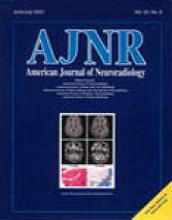Progress in the development of effective stroke therapies has been generally disappointing. The results of initially promising neuroprotective drugs applied in large clinical trials have been unimpressive (1), and the results of large thrombolysis therapy trials have been inconclusive. A missing element in the development of effective stroke therapies has been the lack of available diagnostic tools capable of assessing the viability of brain tissue during the acute stages of evolving stroke. The question that all stroke investigators want and need to know is what brain tissue is salvageable. Indeed in the absence of salvageable tissue, the utility of any therapeutic intervention is moot, but as improved therapeutic interventions are developed, the need to monitor and evaluate tissue status is critical, particularly if we are to identify a therapeutic window.
Diffusion MR imaging is now being widely used clinically for early stroke detection. The underlying mechanisms for changes in diffusion following stroke are still not completely understood; however, the prevailing opinion of many investigators is that cell swelling, along with changes in water tortuosity, are the main factors responsible for diffusion decline with ischemia. In this issue of the AJNR (page 1260), Desmond et al have applied diffusion MR imaging to help qualify the ischemic penumbra, which is thought to be the primary source of salvageable brain tissue. They have shown that diffusion MR imaging can be used to identify salvageable tissue within the ischemic penumbra on the basis of magnitude of decline in the apparent diffusion coefficient (ADC). Regions of the penumbra that maintained a normalized ADC value of at least 0.90 were shown to be unlikely to proceed to infarction, whereas those regions with normalized ADC values between 0.90 and 0.75 were at risk for infarction. This region may be identified as encompassing the salvageable tissue.
By providing a fast, quantitative, and early assessment of brain tissue status and viability, this approach goes a long way toward developing the missing element in our pursuit of efficacious therapeutic interventions. Further studies of this type, combined with perfusion measurements, relaxation time parametric mapping, and measurements of metabolic status should significantly improve our progress in the development of therapies to help better manage the stroke patient.
Reference
- Copyright © American Society of Neuroradiology












